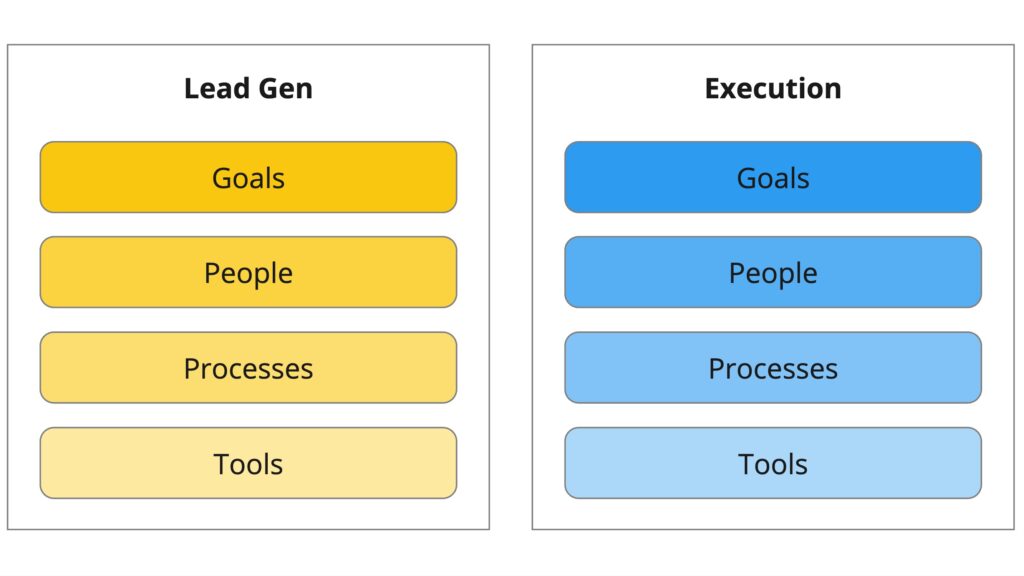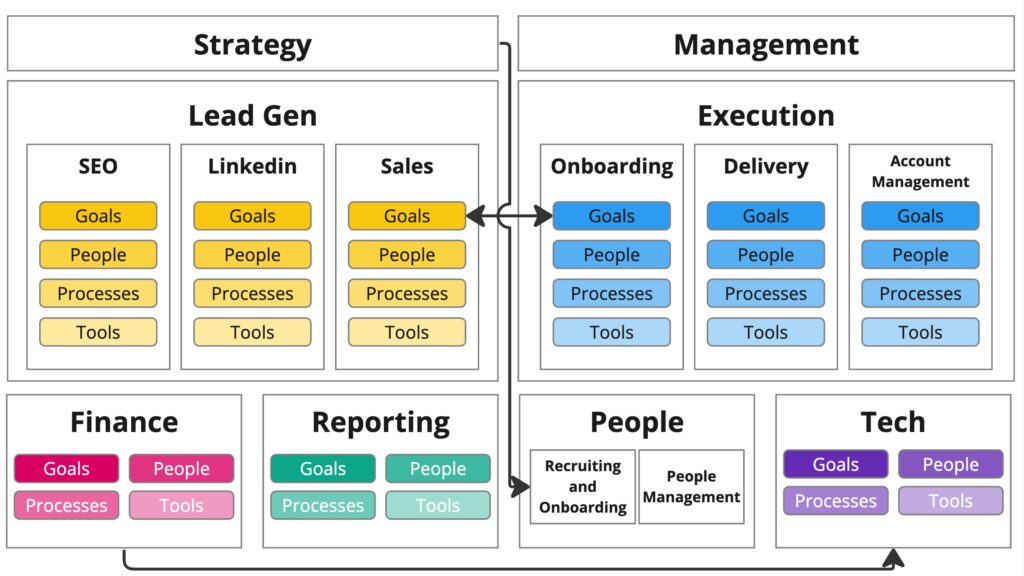How to build business systems for your business
Thinking about your business in terms of systems is a great way of building robust and scalable operations.
For an introduction to business systems, check out this article.
But what business systems does your business need today? And which systems will you need as you grow. In this article, we’ll outline a blueprint for business systems by growth stage.
- Stage 1 from start to 300,000 USD in revenue
- Stage 2 from 300,000 to 1,000,000 USD in revenue
- Stage 3 from 1,000,000 to 3,000,000 USD in revenue
- Stage 4 for revenues of 3,000,000 USD and more
Stage 1: Lead Generation/Sales and Execution
Start to 300,000
At the start of your business, you need to focus on two things only:
- A service or product that you can provide
- A way of finding people to sell to

Execution system
This is the natural starting point of new businesses. You can do something that is of value to the market place. So in this first stage, it’s critical to define how you deliver your service. Let’s break this system down into it’s components:Goal of the execution system
The goal of your execution system is to deliver your service or solution in a repeatable way at the right quality.Processes of the execution system
This is the core of your offering. Map out the process you use to deliver your service for the client. At this early stage, this could be as simple as setting up a template in your task management system or writing an SOP about it. Keep the process as simple as you can at the beginning. Your goal at this stage is to learn what works and what doesn’t.People for the execution system
Chances are that you start off alone. The people aspect of the execution system will be fairly simple. If you start hiring people or using freelancers to deliver your services, create clear job descriptions for them. A good tool to do this is the RACI matrix. In addition, make sure your sales can support any people you bring in. Building the team before you have the sales is a typical mistake founders make.Lead Generation and Sales System
In this early stage, your lead generation and sales can be organized in one system. Both aspects will be fairly simple and mostly run by yourself.Goal of the Lead Generation and Sales System
The goal of your Lead Generation and Sales System is to bring in new clients at low cost.Processes for your Lead Generation and Sales System
The processes for your lead generation system should focus on one, maximum two channels that you get your leads from. Typical channels in the early stages include word-of-mouth or your network. If your using other channels like social, SEO or ads, focus on one thing and do that well. On the sales side, your process will likely still be somewhat organic. As you learn, you can build out a sequence of funnel stages to structure your client conversations.People for your Lead Generation and Sales System
Sales will mostly be your own task at the beginning, as there’s not enough volume to justify a hired or contracted sales person. If you need a dedicated person for lead generation depends on the channel or channels you use. If you’re mainly focusing on your network and word of mouth, it will be you. If you’re looking to build up channels other than that, it can make sense to bring in an expert on a contract basis to help you with the setup. At the early stage, it’s often advisable to bootstrap your efforts, and just bring in experts to design or validate critical aspects of your setup.Tools for your Lead Generation and Sales System
At the beginning of your journey, there’s a number of things you might need on the tool side of your Lead Generation and Sales System:- A website or landing page
- Some branding and positioning
- Potentially sales tools or lead magnets
- Sales scripts or other things you need in your sales conversations
Learn more about how we help clients with business systems:
Check out our Operations Consulting ServicesStage 2: Diversifying and Adding Systems
300,000 to 1,000,000 As your business grows (well done!), you’ll be diversifying your existing systems and add new ones. Important: Keep in mind that these systems vary in size and complexity. You’ll still be heading many of the systems. You don’t have to hire employees or contractors for each system. The goal is to have a structured look at your business functions.Diversifying Lead Gen Systems
As you pass 300k in revenue, and you have mastered your first lead gen channel, consider adding another one. Grow slowly, and focus on nailing each channel before adding a new one. As a rule of thumb, you should only be working on setting up or improving one system at a time. Consider the diversified systems as sub-systems of your Lead Generation Systems.
Diversifying Execution Systems
Onboarding
As your operation grows, you’ll find that you need to streamline onboarding of new clients. This has a lot of benefits: Check out this article about client onboarding and expectation management.
Operations
Your operations, the core of your execution, now should become more and more systemized. This will include standardized processes, templates, workflow and SOPs.
Account Management
At this stage, you’ll find that acquiring new customers is more difficult than retaining existing ones. Also, as your service offerings expand and accounts grow in size, you want to add an account management system that ensures clients feel well taken care of.
Adding Systems
In this stage, two other things become important: Understanding your financials and your KPIs.
Financial
You need to build out a simple (!) financial system. The basic metrics you should track are:
- Gross profit margin
- G&A cost
- Net profit
- Cash flow
Having transparency across these metrics will allow you to hone in on the right type of clients and parts of your offering. Also, you can only make informed decisions when you know your numbers.
Reporting System
As with the financials, you need to get clarity on your performance metrics. Choose KPIs that are critical to your success. Try to keep the number low.
Examples are:
- Lifetime value per customer (by acquisition channel if have multiple)
- CAC Customer Acquisition Cost (per channel if you have multiple)
- Customer Satisfaction or NPS
- Retention rate of clients / Churn rate of clients
- Average engagement length
- Service-related KPIs (like impressions and clicks across and per client account if you’re an SEO agency, etc.)
Again, keep things simple. But do keep track of the KPIs and make them a discussion point in your regular meetings with the team.
Stage 3: Supporting Systems and Management Systems
1,000,000 to 3,000,000
As you get past 85k in monthly revenue, you’ll find that growth often accelerates. This will require you to hire and onboard more people. Also you’ll have to work harder to retain the top talent in your team.
In addition, managing your toolset becomes a task in itself.
And lastly, once you’ve built a well-working operation, you want to be intentional about your strategy development and how you manage your business.

Strategy and Management System
As you pass one million in revenue, it’s time to level up your strategy and management.
Strategy System
Develop a clear way of defining and executing your strategy. This will include regular sessions to set objectives, and a strong strategy execution framework.
Read more about the strategy system here.
Management System
You need to define how you want to manage you business. You might need to implement a leadership team.
You probably also need a meeting structure to ensure communication flows well through the organization, and there’s a place for efficient problem solving and decision making.
Also, consider how you want to deal with decision-making by and large: Do you want to centralize decision making (you calling the shots), or decentralize it.
As a result of your strategy system, especially your strategy execution framework, you need to define how you want to set goals and measure success for your team (your reporting system will come in handy).
People System
At this stage of you company, you need to become intentional about your people management. Focus on three main aspects.
Recruiting and Onboarding System
You should have a clear system in place (again: Goals, People, Processes, Tools) to attract, hire and onboard the talent you need. This will include building a talent pool, having a standardized interview process and nailing onboarding.
Read our comprehensive guide on onboarding here.
Tech System
The larger your business gets, the hight the chances that you tech stack faces a couple of issues:
- Your business has outgrown the capabilities of your existing stack (think managing projects in Google Sheets)
- Your team adds new tools in an uncontrolled way, creating tool debt, a situation where the multitude of tools actually causes more problems than it helps.
- Technological progress offers much better tools than the one you’re using.
In addition, user management and keeping tools well set up becomes a thing.
That’s why you need to implement a tech system, i.e. someone responsible for managing your tech stack, processes to onboard new users or evaluate tools, and a toolset to manage all of these things.
Stage 4: Integrating and Improving Systems
3,000,000 and beyond
As your business matures, so will your systems. Moving beyond 3 million in revenue, you’ll find that the growth creates challenges for your systems landscape.

Breaking up silos
First, you need to work to integrate your systems. This work doesn’t start only here, but it becomes inevitable at this stage.
Make sure that all systems work well together, and the there’s an overlap in people processes and tools as needed.
An example:
- As you sales team gets better at closing, it might sign contracts that your execution team can’t deliver on. You need to fix that, by involving execution team people or at least know-how in the sales process. At the same time, what sales is able to sell can give you valuable information on upgrading your execution system.
- Your strategic planning needs to be integrated with your recruiting plans.
- Your reporting and financial system need to integrate fully with your tech system, to give you real-time information.
These connections are super important, but also create a lot of complexity. Balancing this is key to growing further.
Optimizing your value chain
As you grow, you’ll further and further streamline how you add value to your clients. Constantly try to cut down complexity, focus on what the clients really value, and refocus your offering.
Trimming the fat regularly will help build an efficient and profitable company.
Feedback loops
Ensure that information flows freely between systems, without unnecessary formalization or hierarchy. Where needed, implement formal feedback loops.
Continuous Improvement
Last but not least, your business systems need constant work. Like anywhere in business, there’s no perfect, just improvement.

